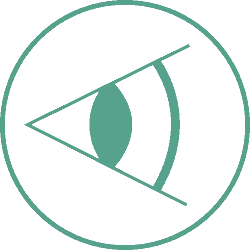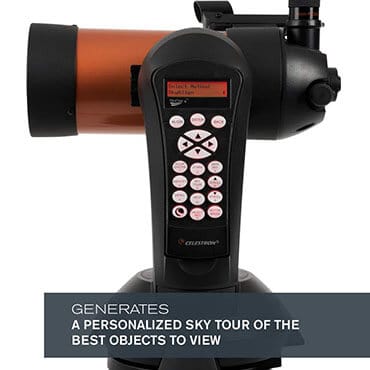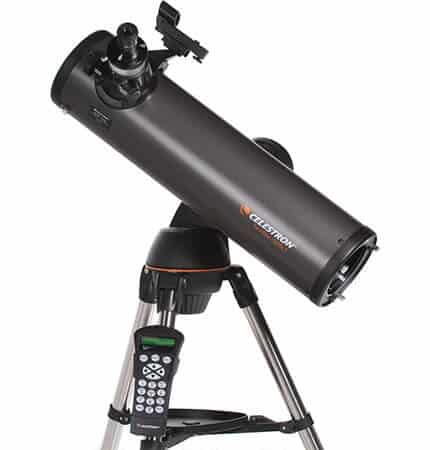Celestron NexStar 4SE Review Telescopes
- Last Updated On:
Among computerized telescopes, the NexStar series by Celestron offers a few very strong competitors. Among smaller and more portable scopes, the Celestron NexStar 4SE is regarded as one of the best scopes for newcomers. In fact is one of our picks for the best telescopes under $500.
Is the orange tube design just meant to look great or is there some solid craftsmanship hidden inside?
It’s time to find out, welcome to our Celestron NexStar 4SE Review!
Introduction
Almost half a century ago, during the 1970s, Celestron has released the famous and sought-after Celestron C8 model. This spectacular scope has stood the test of time and is still very popular, but it is very hard to find as it is very old.
The new Orange Tube series surely makes you think that Celestron is trying to make a buck with the element of nostalgia, right?
Well, you might be right about that. But even so, the NexStar 4SE and the other Orange Tubes are fairly solid scopes, especially for beginners and newcomers. Before we dive into the details, let’s take a quick look over the key features.
Key Features:
Computerized Telescope:
The NexStar 4SE is equipped with a GoTo Mount and the SkyAlign software and a massive database, allowing you to easily find over 40,000 celestial objects, including planets, stars, clusters, galaxies, and nebulae. The stability of the tripod and the strength of the motors are big concerns for GoTo users, but with a small and lightweight telescope like this, those concerns are not a problem.
Maksutov-Cassegrain Design:
Mak-Casses are primarily reflecting telescopes, but unlike ordinary reflectors that only use mirrors, these telescopes use correcting lenses. This type of telescope is called catadioptric and it eliminates aberration commonly found in ordinary reflectors.
4 inch aperture:
With 4 inches / 102 millimeters of aperture, the NexStar 4SE is a fairly small telescope. This means that the images will be dimmer than with bigger telescopes in the series. However, the lightweight design makes it easy to take this telescope into the mountains or another area without light pollution, meaning that you will be able to view all celestial objects in the sky.
SkyAlign technology:
The hardest and most time-consuming part of night sky exploration is the setup and alignment of the telescope. The SkyAlign technology makes this process fast and easy.
Optional NexYZ Smartphone Adapter:
Getting into astrophotography was never easier and cheaper! Just connect your favorite smartphone to the telescope and capture stunning pictures of nebulae, planets and clusters. The adapter is strong, durable and stable thanks to high-end materials used in the construction.

APERTURE
102mm

FOCAL LENGTH
1325mm

MOTORIZED
Yes

Mount type
Alt-Azimuth
- User-friendly software and technology
- High-end materials and craftsmanship
- A lot of features for a very moderate price
- Great beginner telescope and secondary scope for intermediate users
- Small aperture that dims the view unless in an ideal environment
Table of Content
What To expect from the Celestron NexStar 4SE
The Orange Tube Series, reliable telescopes for beginners and pros.
As already mentioned, the modern Orange Tube series was inspired by an older model. The NexStar models come in two designs: the 4SE is a Maksutov-Cassegrain, while the three bigger models are Schmidt-Cassegrain telescopes. Both types of telescopes use spherical mirrors which would normally cause spherical aberration.
These hybrid designs, however, make use of corrector lenses to correct the aberration. Mak-Cass designs are smaller and require a bit more time to thermally equalize when compared to Schmidt-Cass telescopes, while in other aspects, they are mostly similar.

Optics:
The optics of the Celestron NexStar 4SE offer a very good experience, especially for planetary viewing. The materials and craftsmanship of the lenses and mirrors are very good.
The biggest drawback is the small aperture, which will prevent you from gathering enough light for some faint objects. There seems to be a little bit of chromatic aberration, but nothing too major. The 4SE will offers the possibility of deep-sky exploration and imagery, but the results will be limited due to the small size.
You can check our picks by each aperture size here.
Portability:
The biggest advantage and appeal of this telescope is the portability. If you want to go on a camping trip, this is one of the most portable telescopes on the market. Considering that, the low power optics are something you simply have to accept. There is no telescope out there that offers both portability and power, it is always a compromise.
Mount And Tripod:
The tripod used for the NexStar 4SE series is fairly decent, albeit a little bit shaky. This is more pronounced on the bigger and heavier models of the Celestron NexStar series. In this case, however, it is not a real problem. Choosing the correct part of the soil where you will put the telescope might be enough to remove this problem. The DC servo motors are fairly good and the single fork gets the job done. All in all, the weight and durability of this mount and tripod are above average
Computer:
The technology within this telescope makes it fairly easy to use. You have multiple ways of aligning the telescope, including 1-Star Align, 2-Star Align, and Solar System Align. These number of alignment methods can be further expanded with an equatorial wedge, which you would have to buy separately. An equatorial wedge essentially transforms your Alt-Az telescope into an equatorial telescope.
The software included offers the tracking of more than 40000 objects in the sky and a Sky Tour mode which makes astronomy easy and fun. The 4SE also offers compatibility with other products from Celestron, for example, the Skyris cameras.

Making use of a computerized telescope: How to use the SkyAlign system?:
The database for the computerized Celestron NexStar 4SE is rather massive – over 40,000 objects in the night sky can be found with the help of the computer. But before you start exploring the universe, you will need to use the SkyAlign system to align your telescope.
There are multiple modes for using the SkyAlign system, but we will go only over the two most important ones as you will be using those two most of the time.
The first one is the default SkyAlign system, which is a simple 3-Objects alignment. After typing in your location settings, the date and the time, you start out by finding a bright object in the sky. The object can be either a star or a planet – and you do not even have to know which object it is. It is only important to first center your red dot finder to the object and then center the field of view of your primary scope to the object. Afterward, you repeat this same process with two more objects.
The second option is the SkyAlign Precise GoTo setting. This option is very similar to the first setting, the only difference being that it requires 5 different bright points instead of 3. This option is slightly more time consuming as you need to navigate through the menu to find it and because it uses more objects. Another downside of this method is that it requires you to know the name of the objects you are trying to find. That means that you need to first choose an object, then find 5 objects that the telescope asks you to find, and after doing so, the telescope will align to your object of choice. This might seem like a lot of work, but it is the best and most precise way to track an object.
What Can you see with the NexStar 4SE?
As already mentioned, the 4SE is a fairly small telescope with little power and a small aperture. The light-gathering power of this scope is sadly limited due to its size. However, it is strong enough for planetary viewing and terrestrial exploration.
In terms of deep-sky exploration and viewing celestial objects that are not planets, you will absolutely have to take the scope with you to areas with little to no light pollution. That means the countryside, a mountain or a desert. The combination of a clear sky and the Precise GoTo setting is the best way to make use of your telescope, especially if you are interested in astrophotography.
Celestron NexStar 4SE for Astrophotography?
If you are interested in astrophotography, the Celestron NexStar 4SE telescope is a low-budget, entry-level solution. The telescope is very affordable and the Precise GoTo setting will allow you to track an object with great precision. Keep in mind, however, that you will have to invest in good rechargeable batteries or an external power supply for your telescope to work for longer periods of time. Another upside is the NexYZ Smartphone Adapter, which you sadly have to buy separately. The catadioptric design and the high-quality optics will allow your images to be fairly sharp and clear. Most modern smartphones will have a camera that is good enough for beginner-level astrophotography.
As for the downsides, as already mentioned, the 4SE telescope is sadly very limited by the low aperture. You will be limited to planetary imagery and a few clusters, but they will certainly not look as good as the Hubble telescope images.
If you want equipment more suited to take images of the night sky you can read our buying guides about telescopes and cameras for astrophotography.
The Celestron NexStar 4SE Competitors:
If you are not convinced by the NexStar 4SE telescope, you might want to check out a few more models before making your final decision. Here are some suggestions:

Meade Instruments Observer ETX90
The Meade EXT90 Observer has an even smaller aperture, but it comes with equally good optics and a dual fork mount for even better tracking.

Celestron – NexStar 130SLT
The NexStar 130SLT is an affordable computerized telescope that uses a Newtonian Reflector design. It comes with all the advantages and disadvantages of a simple reflector telescope, while at the same time offering far more aperture.

Orion StarSeeker IV:
The StarSeeker IV is in a similar category as the NexStar 130SLT. It is also a purely reflecting telescope that sacrifices some features of Mak-Cass designs in favor of stronger optics. More power for the same amount of money, but as already mentioned, Newtonians come with other disadvantages.
Conclusion
Celestron NexStar 4SE Review
-
Optics
-
Build Quality
-
Portability
-
Value
So there you have it. We just went through all the specs and shared with you what is it like to use the Celestron NexStar 4SE for different situations / uses.
Celestron had made it clear that they produce quality products for different types of users. And this is the case for this telescope. It’s a great choice for beginners who want to get their feet wet on the amazing world of astronomy.
Of ourse you’ll have some limitations, this is definitely not a powerful telescope. Yet it delivers all the aspects a beginner would need to enjoy the night sky. You can also check our buying for its big brother Celestron NexStar 8SE or our buying guide for computerized telescopes.
Happy stargazing!
SUBSCRIBE TO OUR WEEKLY NEWSLETTER


